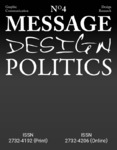Message Graphic Communication Design Research
Issue 4 (2024) DESIGN POLITICS What are the politics of your design and what is the design of your politics?
In the Message journal issue 4 we wanted to create an arena where our discipline could discuss the nature and context of its role from an overtly political perspective.
Whilst we felt in our bones there was an appetite for this, we were far from certain about its nature, scope and size. Consequently, the call for Message 4 was, to say the least, somewhat of a gamble. Thankfully, our hunches and speculations seem to have been close to the mark. We received more submissions for this call than the previous three issues combined.
There was also an anticipation (albeit in hindsight a rather naive one) that some submissions might be positioned around conventional left, right and/or sustainable ecological perspectives. This did not really transpire. Nonetheless, we are very happy to say that the creative, eclectic and diverse nature of the responses has resulted in a range of exemplars that reflect the varied nature, concerns and foci of our vibrant discipline.
These extend from John Calvelli’s philosophical dialectic on the fundamental nature and origin of images, their use and effects, to Elizabeth Herrmann’s self-initiated craft-based approach, to do good locally and make a social contribution. Both of these papers are also examples of the higher than usual number of submissions from North America, a substantial proportion of which relate to the politics of cultural and/or racial identity, such as Omari Souza’s, ‘Racist Motifs in Everyday Branding’.
Message is dedicated to the development of Graphic Communication Design research. Particularly (although not exclusively) through authors’ analysis of and reflection on their own practice-based research.
Through peer reviewed submissions and occasional commissioned essays, Message explores, discusses and challenges the boundaries, roles, practices and outputs of Graphic Communication Design. Past, present and future.
Full Issue
Message Journal, Issue 4: DESIGN POLITICS What are the politics of your design and what is the design of your politics?
Peter Jones, Camilla Afanador-Llach, Anne Berry, Sarah Rutherford, John Calvelli, Kristen Coogan, James Dyer, Cathy Gale, Anne M. Giangiulio, Elizabeth Herrmann, Chae Ho Lee, Gwen Lettis, Pamela Napier, Adam de Eyto, Muireann McMahon, Omari Souza, and Dave Wood

Table of Contents
Introduction
Peter Jones
Rethinking Graphic Design and the Design of Historical Arguments
Camilla Afanador-Llach
The Intersection of Electoral Politics and Design Education
Anne Berry and Sarah Rutherford
Ecological Mourning and the Work of Graphic Communication Design
John Calvelli
From High to Low and High Again
Kristen Coogan
Speculative Graphic Design: The Idiot’s-Eye-View
James Dyer
Free!* Reclaiming ‘freedom’ from the neoliberal lexicon
Cathy Gale
Countering ‘Fake News’ in the Design Classroom
Anne M. Giangiulio
Cards for Humanity: Constructing Meaningful Communities Through Unsolicited Do-Good Design
Elizabeth Herrmann
Political Awareness and Engagement Through Banknote Design
Chae Ho Lee
Personal value thinking in graphic communication design education – The introduction of a clarification tool for students
Gwen Lettis, Pamela Napier, Adam de Eyto and Muireann McMahon
Passive, Brutish, or Civil? Racist Motifs in Everyday Branding
Omari Souza
Countering the Othering of Others: Illustration Facilitating Empathy
Dave Wood
Re-contextualising Illustration to Inform Sexual Consent – #JustSoYouKnow
Dave Wood

